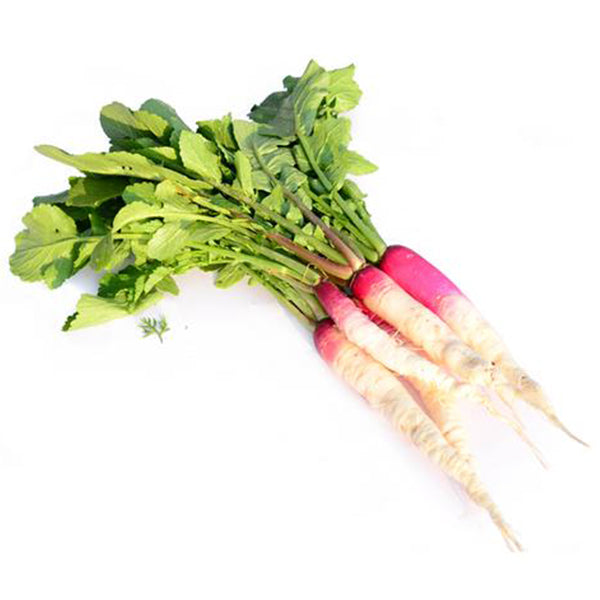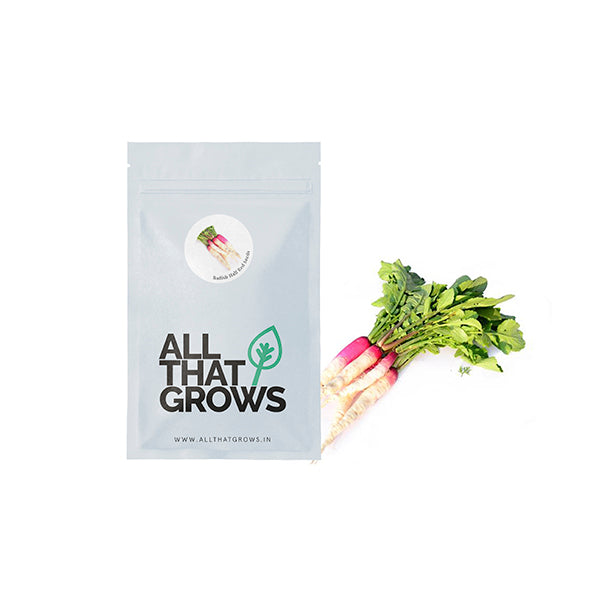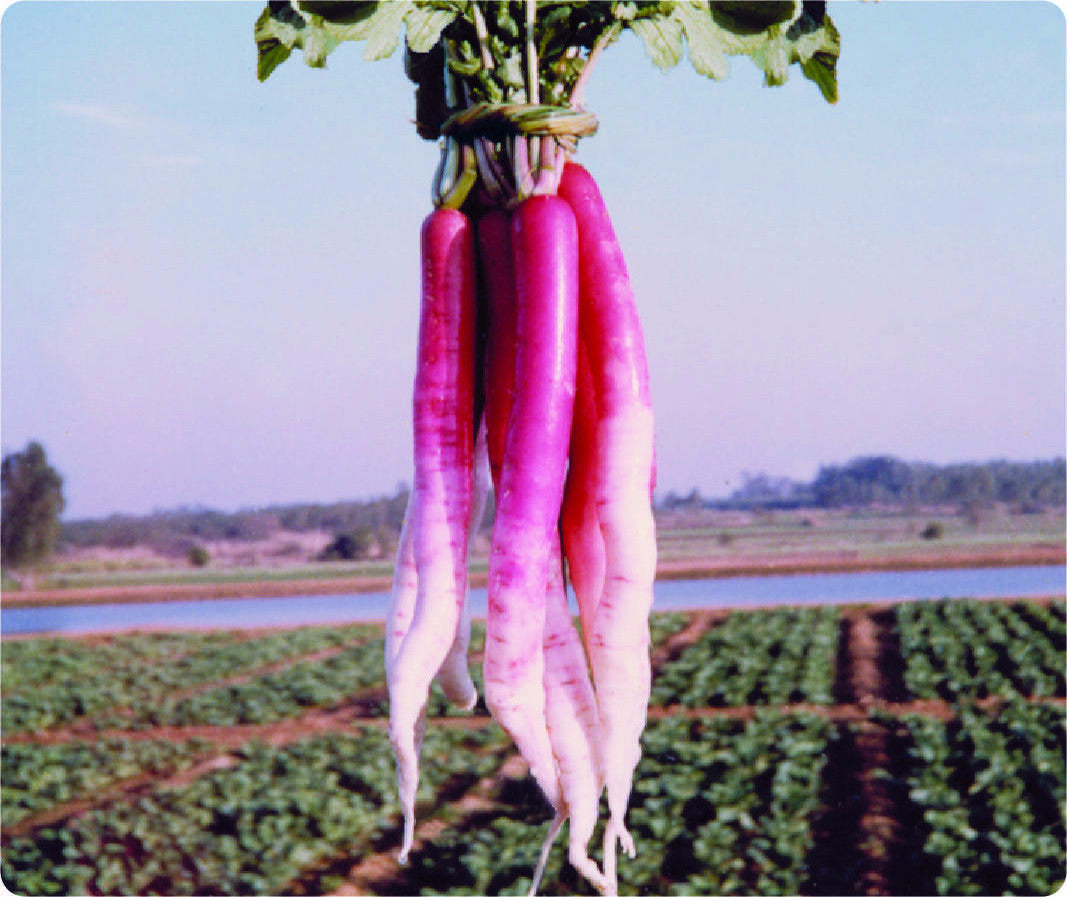





Radish Half Red Seeds
Seed Type : Non-Hybrid, Open Pollinated and Non-GMO
Sowing Time : Suitable for June to November sowing
Root colour : Upper half portion is red and lower half portion is white
Specification : Roots thin, 10-12 inches long, sleek and tapering in shape
Maturity: After 40-45 days from sowing
- SOWING
TIMEJune - November
- Sowing
DistanceLine to line 12"
seed to seed 2-3" - Fruit
WeightN/A
- Fruit
ShapeLong and tapering
- Days to
maturity40-45 days
- Details
- How to sow
- Reviews
Growing radishes in your garden would invariably mean better health and nourishment for your family. Radishes, in themselves, are extremely healthful and nutritious, and if you grow them in your very own kitchen garden, they will only turn out more delicious and healthful. And they are also pretty to look at! Radishes have been part of the Asian culinary history since pre-historic times and their status as health foods has only increased and become better. Radishes are an essential ingredient of Japanese, Chinese, and even Indian food culture. Daikon is the popular white radish which has many varieties such as the red radish, the half-red radish and others. The half-red radish is not as pungent and sour as the red radish. Out of the three and different varieties of radishes, the most mild in flavor is the white radish. Nonetheless, their nutritional content and density is the same across the spectrum. The half-red radish is as nutritionally dense as its counterparts which means you get an abundant supply of Vitamin C, Iodine, Folate, Potassium, antioxidants, anthocyanins, etc. Radishes are great for enhancing and improving immunity and are a natural coolant for the body. The vegetable aids in digestion, is low in calories, and a great detoxifier.
Preferably eaten raw in salads and sometimes sandwiches, the radishes can also be cooked, steamed, and added to soups for a wholesome meal. Chomp on them and enjoy good health. But first, shop the seeds that will make beautiful half-red radishes grow in your gardens.
Planting instructions
Plan a fall planting. Plant 4-6 weeks into fall before the start of the winter.
Directly sow seeds ½ to an inch deep and one inch apart in rows that are 12 inches apart.
Thin to about 2-inch spacings. Avoid crowding of plants together.
Radishes when planted in too much shade—or even where neighbouring vegetable plants shade them—they invest all their energy into producing bigger leaves.
Practise 3 year crop rotation.
Growing Requirements
watering
Radish seeds should be planted in moist soil during mid-autumn. Infrequent watering gives radishes a woody texture and a hot taste. Keep soil evenly moist but not waterlogged.
pests
The pests that attack radish can cause the roots to fail to form, tiny shot-holes in leaves of seedlings, leaves to turn dull yellow, curl, stunted - making them brittle and deformed. Common type of pests that affect this crop are Cabbage Root Maggot and Clubroot.
soil
Radishes prefer well-drained, loose soil, high in organic matter, free from stones, with pH 5.8 to 6.8.
spot
The crop yields best produce in full sun.
temperature
Ideal temperature for germination would be 12 to 29 degree C [55 F to 85 F].
how to harvest
Radishes are quick to harvest, as rapidly as three weeks after planting.
Do not leave them in the ground for long after they have reached maturity, their condition will deteriorate.
Trim the tops off short, wash the radishes and dry them thoroughly.
Store in refrigerator in plastic bags. Radish greens can be stored separately for up to three days.

Customer Reviews
The productiveness of any seed we sell is subject to your local climatic conditions*, the sowing method you adopt, and your commitment to the planting process. We give no warranty, expressed or implied, and are in no way responsible for the produce.
Please note that all our seasonal recommendations/ sowing information is as per the local climatic conditions. *For more information on the optimum conditions required for growing seeds in your region, please contact us at, hello@allthatgrows.in or Whatsapp us at, +91 8544865077
Questions & Answers
Have a Question?
Be the first to ask a question about this.






Radish Half Red Seeds
Seed Type : Non-Hybrid, Open Pollinated and Non-GMO
Sowing Time : Suitable for June to November sowing
Root colour : Upper half portion is red and lower half portion is white
Specification : Roots thin, 10-12 inches long, sleek and tapering in shape
Maturity: After 40-45 days from sowing
Growing radishes in your garden would invariably mean better health and nourishment for your family. Radishes, in themselves, are extremely healthful and nutritious, and if you grow them in your very own kitchen garden, they will only turn out more delicious and healthful. And they are also pretty to look at! Radishes have been part of the Asian culinary history since pre-historic times and their status as health foods has only increased and become better. Radishes are an essential ingredient of Japanese, Chinese, and even Indian food culture. Daikon is the popular white radish which has many varieties such as the red radish, the half-red radish and others. The half-red radish is not as pungent and sour as the red radish. Out of the three and different varieties of radishes, the most mild in flavor is the white radish. Nonetheless, their nutritional content and density is the same across the spectrum. The half-red radish is as nutritionally dense as its counterparts which means you get an abundant supply of Vitamin C, Iodine, Folate, Potassium, antioxidants, anthocyanins, etc. Radishes are great for enhancing and improving immunity and are a natural coolant for the body. The vegetable aids in digestion, is low in calories, and a great detoxifier.
Preferably eaten raw in salads and sometimes sandwiches, the radishes can also be cooked, steamed, and added to soups for a wholesome meal. Chomp on them and enjoy good health. But first, shop the seeds that will make beautiful half-red radishes grow in your gardens.
Seed Type : Non-Hybrid, Open Pollinated and Non-GMO
Sowing Time : Suitable for June to November sowing
Root colour : Upper half portion is red and lower half portion is white
Specification : Roots thin, 10-12 inches long, sleek and tapering in shape
Maturity: After 40-45 days from sowing
- SOWING
TIMEJune - November
- Sowing
DistanceLine to line 12"
seed to seed 2-3" - Fruit
WeightN/A
- Fruit
ShapeLong and tapering
- Days to
maturity40-45 days
Planting instructions
Plan a fall planting. Plant 4-6 weeks into fall before the start of the winter.
Directly sow seeds ½ to an inch deep and one inch apart in rows that are 12 inches apart.
Thin to about 2-inch spacings. Avoid crowding of plants together.
Radishes when planted in too much shade—or even where neighbouring vegetable plants shade them—they invest all their energy into producing bigger leaves.
Practise 3 year crop rotation.
Growing Requirements
watering
Radish seeds should be planted in moist soil during mid-autumn. Infrequent watering gives radishes a woody texture and a hot taste. Keep soil evenly moist but not waterlogged.
pests
The pests that attack radish can cause the roots to fail to form, tiny shot-holes in leaves of seedlings, leaves to turn dull yellow, curl, stunted - making them brittle and deformed. Common type of pests that affect this crop are Cabbage Root Maggot and Clubroot.
soil
Radishes prefer well-drained, loose soil, high in organic matter, free from stones, with pH 5.8 to 6.8.
spot
The crop yields best produce in full sun.
temperature
Ideal temperature for germination would be 12 to 29 degree C [55 F to 85 F].
how to harvest
Radishes are quick to harvest, as rapidly as three weeks after planting.
Do not leave them in the ground for long after they have reached maturity, their condition will deteriorate.
Trim the tops off short, wash the radishes and dry them thoroughly.
Store in refrigerator in plastic bags. Radish greens can be stored separately for up to three days.



 Sign In
Sign In








